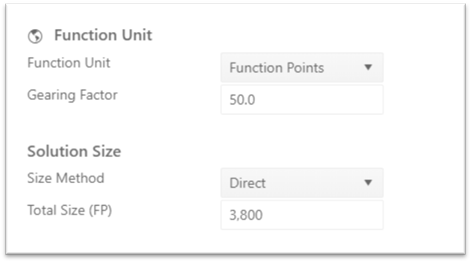Choosing a Function Unit
The first step in constructing a size estimate is to make
sure the Function Unit (the component used to describe/capture system size) is
appropriate for your project and for the sizing technique you plan to use for
estimation. For new projects, the information in the Function Unit section of
the Sizing tab was “inherited” from the configuration source – template or
existing project – used when the project was created. Note that the data fields
in this section are global ones  , meaning they apply to all solutions for the
project: current, logged, and Balanced Risk. Changing the function unit or
gearing factor will cause the size for any existing solutions to be recalculated
to an equivalent size in base size units (captured using the new function unit
and/or gearing factor). Think of the process as “translating” the current
size into your preferred function unit and gearing factor. Of course, you
may also want to edit the size (function unit count) – doing so will generate a
new size estimate.
, meaning they apply to all solutions for the
project: current, logged, and Balanced Risk. Changing the function unit or
gearing factor will cause the size for any existing solutions to be recalculated
to an equivalent size in base size units (captured using the new function unit
and/or gearing factor). Think of the process as “translating” the current
size into your preferred function unit and gearing factor. Of course, you
may also want to edit the size (function unit count) – doing so will generate a
new size estimate.

Though in most cases you will not need to change the
Function Unit section defaults from your configuration source, it’s still a good
idea to understand how they are defined and used. In SLIM tools, project size
has two aspects:
•
Function Unit. The function unit is a way of representing the
size of the developed software product (newly developed, modified, or reused
software). Examples are: 100,000 logical source statements (lines of
code), 2000 function points, 300 stories or 900 story points, 250 requirements,
or 28 web pages. Regardless of the function unit chosen, you will be
estimating the number of components that will be constructed or modified,
tested, and delivered by the current project. QSM support
can help with size estimation.
If you need to add a function unit to the
list of available size units, contact your site administrator and ask him or her
to add the desired unit to the selection list. If an uploaded Estimation
project, template, or SLIM-DataManager database contains function units with no
counterpart in the Function Units table, the “new” function unit will be added
to the Function Units lookup table. The Administrator will have the option
to validate this function unit and include it in drop-down lists available to
other SLIM-Collaborate users and projects.
•
Gearing Factor. The gearing factor normalizes projects with
size measured in different sizing units to a common frame of reference: the base
size unit. For example, a project with 50 function points at a gearing
factor of 50 converts to 2500 (50 FP * 50 base size units per FP) base size
units. One hundred objects at a gearing factor of 300 is equivalent
to 30,000 base size units (100 objects * 300 base size units per object). The
base size unit represents the smallest identifiable unit of programming work: it
is roughly equivalent to the time and effort it takes to write one line of
code. SLIM-Collaborate provides a default gearing factor for each of the
function units but you can replace the default gearing factor with one from your
history.
The project size is used during benchmarking and
calculation of the PI or other productivity metrics (Size per phase 3 effort
unit or phase 3 month). Because all of the major management metrics – schedule,
effort or labor cost, defects, productivity – naturally scale with project size,
size data is also used to position projects against similarly sized projects on
relevant internal or industry trend lines.
 , meaning they apply to all solutions for the
project: current, logged, and Balanced Risk. Changing the function unit or
gearing factor will cause the size for any existing solutions to be recalculated
to an equivalent size in base size units (captured using the new function unit
and/or gearing factor). Think of the process as “translating” the current
size into your preferred function unit and gearing factor. Of course, you
may also want to edit the size (function unit count) – doing so will generate a
new size estimate.
, meaning they apply to all solutions for the
project: current, logged, and Balanced Risk. Changing the function unit or
gearing factor will cause the size for any existing solutions to be recalculated
to an equivalent size in base size units (captured using the new function unit
and/or gearing factor). Think of the process as “translating” the current
size into your preferred function unit and gearing factor. Of course, you
may also want to edit the size (function unit count) – doing so will generate a
new size estimate.